2. An Introduction to Waterdeep
|
|
|
|
|
|
| 1st Edition AD&D |
|
- |
|
|
A BRIEF GEOGRAPHY
OF WATERDEEP
The City of Splendors lies on the western
coast of Faerûn, north of Amn. That
region
is known as "the Sword Coast,"
because for
many years it was ruled by the might of
swordarms rather than by any laws or treaties
(and some folk in the South still hold it
to be so). Waterdeep's boundaries are strictly
controlled by the mysterious rulers of the
City, the Lords of Waterdeep.
Waterdeep is guarded by a wall from its
southern tip to the northern end of the City
of the Dead, where there is a sheer cliff
of
over a hundred feet in height, by the
Trollwall (so named because of its earliest
form it was intended primarily to hold off
trolls), which rises up again
after the cliff
lessens to a height that attackers could
scale, and extends as far as the Trolltower,
or Northtower, before doubling back south
to meet the sea.
This wall is pierced by 4 gates: the
South Gate; the River Gate; Northgate; and
Westgate. Within the walls, the city of
Waterdeep sprawls to the shore, except
where restrained by edict of the Lords, who
forbid any habitation of encroachment into
The City of the Dead, the public streets,
and
the slopes of Mount Waterdeep
around Castle
Waterdeep.
The Watch (City police) divide the City
into 7 districts, or "wards." These are
Castle Ward, the City of the Dead, Sea Ward,
North Ward, The Trades Ward, Dock Ward,
and Southern Ward. Divisions between
these districts are not obvious to a visitor to
the City. Industry and other activities are
not restricted to this or that ward (the
exception being the City of the Dead). The
complex ward boundaries are shown on a
map included in this book.
* Castle Ward contains Mount Waterdeep,
the Castle itself, Piergeiron's Palace,
and many of the barracks and other public
buildings around them. Generally only the
wealthy live here, and then only if they are
involved in the daily intrigue and "night life"
open social cut-and-thrust of City life.
* Sea Ward lies to the north and west of
Castle Ward, all along the seacoast.
It contains
most of the large temple complexes
found in the City of Splendors, and many
large private villas of the noble families and
the very rich non-nobles. If one is not noble,
and not a "swinger" or diplomat, but
becomes very wealthy, the Sea Ward is the
place to live.
* North Ward takes in the eastern portion
of the northern end of the sprawling
City, as far south as The City of the Dead.
It
contains many noble villas and grand
houses, but the PRESENCE of many inns and
rooming-houses make it slightly less haughty
in overall character than Sea Ward. North
Ward inhabitants are generally thought of
as very respectable and prosperous.
* The City of the Dead is a walled cemetery,
strictly patrolled by the Watch. So one
may live or even sleep overnight therein.
It
is kept in a beautiful, park-like open condition,
and is used as a launching and meeting
place by natives of Waterdeep at all hours.
* The Trades Ward lies generally to the
south of Castle Ward and The
City of the
Dead, and is an arbitrary slice of
the bustling
commercial area of the City, where
most moderately wealthy merchants
live,
and much of the City's light-goods and
respectable TRADE takes place.
* Southern Ward, as its name implies,
is
the southern end of Waterdeep, and dominated
by the caravan TRADE, with its necessary
stables and warehouses. Many poor
but honest Waterdhavians live here.
* The Dock Ward takes in the entire dock
area from the Mountain to the southern end
of the City, and is the most crowded, dirty,
and "rough" district of the City. The vital
commerce (and shady dealings) of Waterdeep
keep its streets busy at all hours.
Any aerial visitor to the City of Splendors
arriving from the south can clearly see the
general topography of Waterdeep; the City
resembles a flat board raised at its north
end, and slightly tilted downwards on the
west so that it slopes down towards the
Mountain, leveling off along The Way of the
Dragon. Mount Waterdeep is of course the
highest point in Waterdeep; its seaswept
flanks rise to shield much of the City
beyond from the worst coastal storm
winds, peaking some seven hundred feet
above the waves. An eyrie for aerial traffic,
garrisoned by the City Guard (the difference
between Guard and Watch is explained
later in this chapter), shelters below the
peak on the landward side. From it, the
City's defensive naval combat "throwers"
are commanded, and patrol squadrons of
griffon-riders fly.
As a port, Waterdeep provides an excellent
natural deep-water harbor (hence its
name) and shipbuilding facilities;
over 400 vessels can dock at once. Waterdeep
maintains a small navy of 16 FAST
"rakers": slim top-armored vessels that can
carry up to 70 troops each, and that
are armed with fire-pot catapults
and large
deck-mounted crossbows.
These ships have armored bow rams,
banks of oars (and a normal crew of 36
to man them), and 2 masts for crowding
sails on in pursuit or when SPEED is
essential.
The navy's base is fortified Deepwatch
Isle, which protects the harbor mouth from
weather and from seaborne attackers, and
is garrisoned by almost 1000 guardsmen
at all times. At least 2 naval rakers
are always on patrol outside the harbor, and
another 2 are on "READY" duty within the
harbor. At least 4 others will be on
extended patrol somewhere off the Sword
Coast on any day in peacetime.
These warships
are supported by over 20 small
lateen-sailed galleys, or "strikers," and 15
large, wallowing troop-and-supply vessels.
(For AD&D® game statistics of
these
vessels, refer to the "Waterdhavian
Ship
Table" listed under
"The Order of Master
Shipwrights" in Chapter 5.)
Most merchant + ships
of The Realms can
average 50 miles or so per day, in moderately
favorable conditions. Sailing in the
Sword Coast region is dangerous
to impossible
(as one goes northwards and icebergs
become more common) during the harsh
storms of WINTER. Storms are almost continuous
in the month of Hammer, and frequent
in the 2 months that follow, becoming
increasingly fierce but shorter, and with
longer intervals between. Thereafter, in the
4th month, they are replaced by cold,
heavy rains that rarely involve LIGHTNING or
high winds, and are fairly safe (if
uncomfortable)
for sailing.
The City of Waterdeep is built upon the
rock and rubble of the slopes of Mount
Waterdeep, built up and quarried flat over
generations of habitation. At least 3
major networks of underground passages
are known to exist beneath Waterdeep's
busy streets. Undermountain, a deep,
many-leveled former dwarven city and
mine of great antiquity that, as its Name
implies, lies largely beneath Mount Waterdeep,
is the largest and most famous (in
tavern-TALK) of these. The Dungeon of the
Crypt, so named because its above-ground
entrance is one of the crypts in
The City of
the Dead, lies under The
North Ward, and is
less spoken of.
The 3rd of these labyrinths is the city
sewers, detailed in this book. The major <link>
channels of the sewers are navigable, and
the secondary channels may be crawled or
swum by man-sized beings of bravery
(or
stupidity), daring, and agility, although the
curious are warned that the sewers have
gratings at awkward places to prevent their
use as a subterranean highway && to hamper
the movements of less desirable visitors
from the sea depths.
Fresh, clean water (for drinking and
cooking)
in Waterdeep comes from deep wells
under Castle Waterdeep and under Farwatch
Tower, and from shallow wells.
These wells are attended at all times by
members of the Watch. To deliberately poison
|or| attempt to block access to or fill in
one of these wells is an offense punishable
by immediate (i.e. as soon as the offender is
within blade's reach) death. "Spillwater,"
the
not-quite-so-clean water used for bathing
&& washing of animals, buildings,
and
equipment, && for the watering of
plants,
is gained from cisterns on the roofs && in
the cellars of most buildings in Waterdeep;
cellar cisterns are fed by sloping catchbasins
on roofs, and have gratings to filter
solid debris that finds its way onto the roof
out of the collected water as it flows down
wall pipes into the cellar; smaller roof cisterns
are merely open-topped basins, and
are cleaned often by users below to avoid
contact with dead pigeons and the like.
Used spillwater is referred to as "nightwater
", and is used to sluice chamber pots into
the sewers.
Waterdeep's population rarely falls below
122,000 beings. The actual number varies
greatly with the seasons, as so much of it
consists of those visiting in the course of
conducting TRADE. In times of busiest TRADE,
the City often holds 5 times as many. Such
busy times (apart from special occasions
caused by wars, bountiful harvests,
Shieldmeet -- described in
the Campaign
Set--and the like) occur fairly
regularly at
"full spring," when WINTER is fully gone without
threat to the reasonable-minded of its
return && the transportation routes over
land && sea are fully open, and after the
fall harvest in The North (before the
threat
of winter's mud can become a reality, closing
the roads, && the granaries and warehouses
are bursting with food destined for
The South).
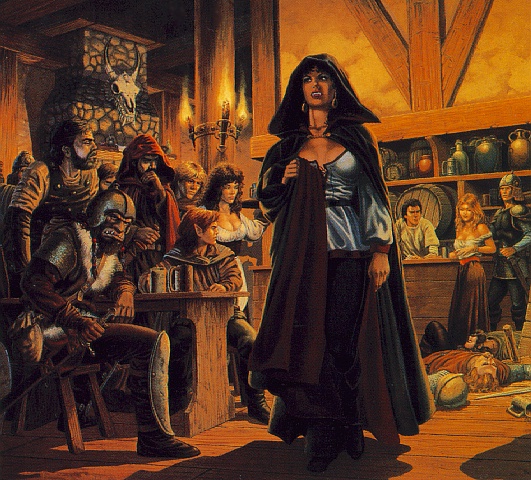
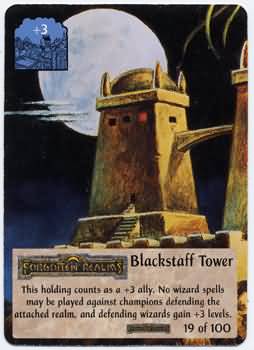
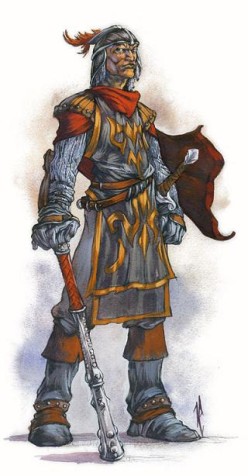
City Guard (Waterdeep)
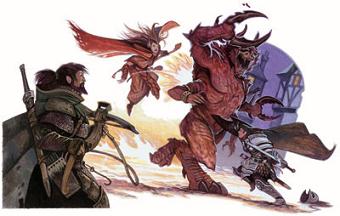
Gray Hands
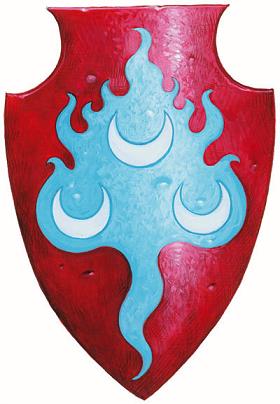
Amcathra
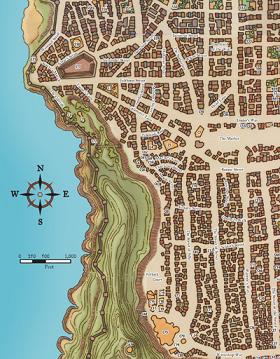
Castle Ward
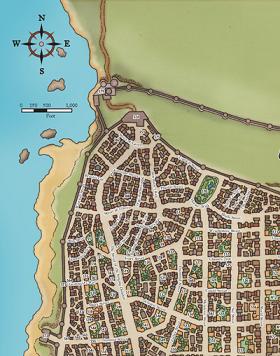
Sea Ward
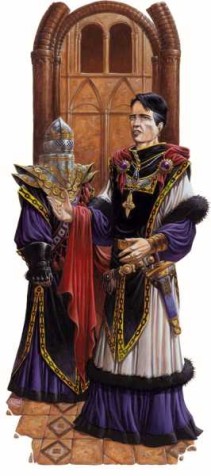
Lords of Waterdeep
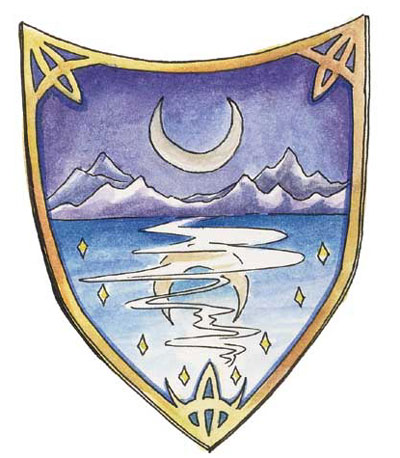
Waterdeep Heraldry
![]()
Reduce - Reuse - Recycle